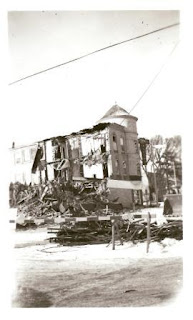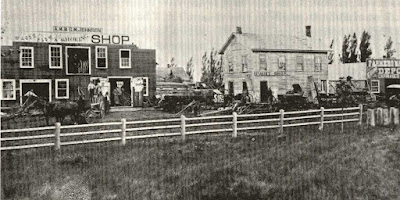One
of the houses featured in “Picturesque Algona” was the residence of Captain
Dana D. Dodge at 721 East McGregor. This
history of this house is somewhat baffling as information gathered does not
seem to point to the fact that the house belonged to Captain Dodge in 1900 when
“Picturesque Algona” was printed.
 It
appears the house was actually built by Maggie Wartman who purchased the
property in 1894. Mrs. Wartman took
quite a circuitous route to get to Algona.
Born at Newberg, Ontario, Canada, she came to Newton County, Indiana
with her husband in 1865. By the fall of
1880, they had moved near Hardy in Humboldt County, Iowa. From there they moved to LuVerne and opened a
mercantile which they ran for several years.
For a short time they moved to Marshalltown after which they finally
came to Algona, purchasing the property in question.
It
appears the house was actually built by Maggie Wartman who purchased the
property in 1894. Mrs. Wartman took
quite a circuitous route to get to Algona.
Born at Newberg, Ontario, Canada, she came to Newton County, Indiana
with her husband in 1865. By the fall of
1880, they had moved near Hardy in Humboldt County, Iowa. From there they moved to LuVerne and opened a
mercantile which they ran for several years.
For a short time they moved to Marshalltown after which they finally
came to Algona, purchasing the property in question.
The
obituary of Mrs. Wartman printed in 1908 states that they built the “cozy
residence now occupied by Capt. and Mrs. D. D. Dodge.” However, this is where the history of the
house gets a little foggy. The obituary goes on to intimate that the
Wartmans were living in the house at the time her husband died in 1904. Real estate transfer records show that Mrs.
Wartman deeded the house to Captain Dodge in the same year. I have been unable to find any confirmation
of death of a Mr. Wartmen during that year in Algona. So, were the Dodges dwelling there in 1900
when “Picturesque Algona” was printed? I
guess there is no way to confirm that one way or the other, but they must have
had some connection to it to have it identified as their home in the book. Perhaps the Dodges were renting the residence
and ended up buying it a few years later.
CAPTAIN
AND MRS. D.D. DODGE
 |
| Capt. D.D. Dodge Photo from Find-A-Grave |
Dana
and Lydia Dodge also took a meandering route to Algona. Captain Dodge was born in Tunbridge,
Vermont. He was married to Lydia Curtis
on May 26, 1855 in Illinois. The new
Mrs. Dodge was born in Rome, New York, where she grew up. When she was 20 years old, she had moved with
her parents to Aurora, Illinois. She and
the captain were married the next year.
After
five years in Illinois, the young family moved to Janesville, Wisconsin. When the war between the states erupted, Dana
heard the call to serve so he left his wife and children and enlisted in
Company D, Second Wisconsin Infantry as a second lieutenant. Eventually he rose to the rank of captain,
but he suffered a sunstroke at the first Battle of Bull Run and had to resign
his commission in early 1862. Returning
to his family, they moved to Minneapolis where they resided until 1875 when
they moved to Kossuth County, settling on a farm near Irvington.
Retiring
from farm life in 1892, the couple moved to Algona. They were already well known in the
area. Captain Dodge had been an active
member of the G.A.R. and the Knights of Pythias for many years. In his retirement he served as president of
the fair board. Lydia was a valued
friend and neighbor who was a faithful servant to her church and the Women’s
Relief Corps.
On
the occasion of their golden wedding anniversary, a large group of friends
gathered at the couple’s home. The
G.A.R. and the Women’s Relief Corps presented Capt. and Mrs. Dodge with elegant
gold pins bearing the emblems of the two organizations. The Knights of Pythias presented a gold
headed cane to the captain and a gold handled umbrella to Mrs. Dodge. Many other fine gifts were given by family
and friends including a string of gold beads that had belonged to the
grandmother of Mrs. Dodge, which she had not seen for fifty years. Local attorney Timothy Harrington made the
presentations and Capt. Dodge expressed their thanks, but was almost too
overcome to do so.
 |
| Lydia Curtis Dodge Photo from Find-A-Grave |
The
Dodges continued to live in the house until Dana passed away in 1913. In his obituary published in the Kossuth
County Advance on April 16, 1913, Captain Dodge was described as “a sturdy type of citizen whom everybody
respected. He was big in body and must
have been a very handsome man in his prime.
He had a soldierly bearing which he maintained until the last. His voice was heavy but kind. He loved his close friends and was by them in
turn beloved. Nothing pleased the
Knights of Pythias better in his later years then to have him present at a
meeting of the lodge. On these rare
occasions he shook off his years and was again a boy with the boys. When he was 83 or 84 years of age he would
still meet with them to enjoy special events, and none stood more erect than he
when the Chancellor Commander’s gavel rapped out an order to arise. When the meeting was over he would stalk off
through the dark to his home, scorning all offers of company unless someone
happened to be going his way. He was a
fine, self reliant old man, a true Knight and a brave gentleman.”
A
few years before her death, on the occasion of her 75th birthday,
twenty-five of Lydia’s closest friends came to the house to surprise her. The house rang with merriment as the guests
reminisced and shared their memories of years past. A special poem written especially for Lydia by
Caroline Ingham was presented to her. It
was published in the Upper Des Moines-Republican on March 17, 1909, and reads
as follows:
Backward, turn
backward, O Time in your flight,
Make me a child
again, just for tonight.”
Why turn backward to
the things that are lost?
What if
the golden hair is tinged with the frost?
What if the eyes that
once sparkled are dim?
The
true life undaunted is all radiant within.
The hope that
outlasts the storm’s rigor of years;
The
love that knows nothing of failure and fears;
The joy that soars up
as the bird on the wing
And
finds its true home where the glorified sing.
O the peace that
comes gently to those who obey;
Who
walk in the spirit with God all the way;
Who let go the
earth-chords without murmur or sigh,
When
the vision grows brighter and the heavens draw nigh.
Thus may life’s sunny
landscape fade softly away,
And
blend its sweet colors with the bright dawning day,
And may the loved
pictures of youth come once more,
To
greet you—all glorified—on the evergreen shore.
Lydia
Curtis Dodge sold the residence in May of 1915.
She moved in with her daughter, Helen Paxson, where she died in December
of that same year.
A
HOUSE FULL OF MEMORIES
 |
| The front of the house in 2016 |
There have been several structural changes to the house through the years including an addition on the back of the house, removing the bay window. The photo in "Picturesque Algona" shows the back of the house taken from a northwesterly direction. I found it surprising that the photo in the book was not the front of the house. However, when researching these stories, I try to remember that the streets and neighborhoods did not look like they do today and perhaps what we see as the back of the house was actually the front of the house for the Dodges. Due to garages built in the area today, I was unable to get a photo from the exact direction from which the old one was taken, but I hope you can make the comparison.
The house went on to be owned by many others, including the current owner, Nancy Yeoman. The Yeoman family has a long history in the house, covering three generations. George and Jennie Yeoman purchased the house in 1919 and lived there until 1945. For two years it was owned by another party until it once again returned to the family when it was purchased by Mary Helen Yeoman, the wife of George and Jennie’s son, Bernard. In May of 1971, the next generation, Richard and Nancy Yeoman, became the owners.
Almost
one hundred years of memories have been made by the Yeoman family in this
house. It has also hosted many
gatherings by other owners with music by the Algona Harp Orchestra and guests such as Mr. and Mrs. Lewis Smith, Mr.
and Mrs. David King, and Captain and Mrs. W.H. Ingham. Oh, the stories this house could tell!
Until
next time,
Jean,
a/k/a the Kossuth County History Buff
If you enjoyed this
post, please don’t forget to “like” and SHARE to Facebook. Not a Facebook
user? Sign up with your email address in the box on the right to have
each post sent directly to you.
Be sure to visit the
KCHB Facebook page for more interesting info about the history of Kossuth
County, Iowa.
Reminder: The posts on Kossuth County History Buff are ©2015-16 by
Jean Kramer. Please use the FB “share” feature instead of
cutting/pasting.













